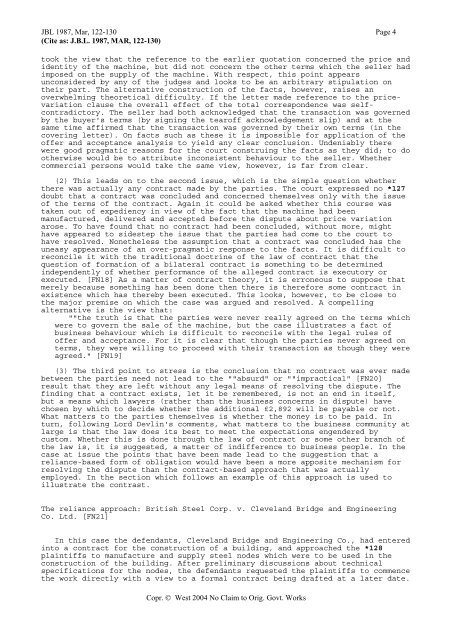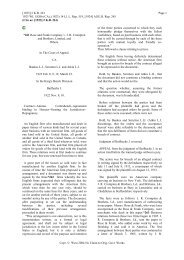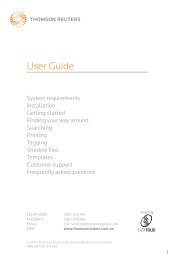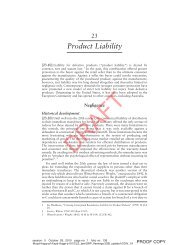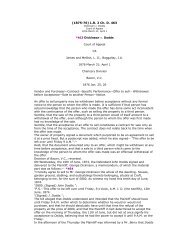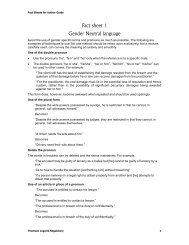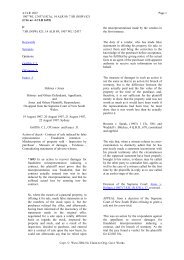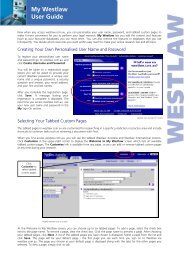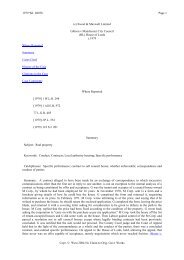Tesco v Constain - Thomson Reuters
Tesco v Constain - Thomson Reuters
Tesco v Constain - Thomson Reuters
You also want an ePaper? Increase the reach of your titles
YUMPU automatically turns print PDFs into web optimized ePapers that Google loves.
JBL 1987, Mar, 122-130 Page 4(Cite as: J.B.L. 1987, MAR, 122-130)took the view that the reference to the earlier quotation concerned the price andidentity of the machine, but did not concern the other terms which the seller hadimposed on the supply of the machine. With respect, this point appearsunconsidered by any of the judges and looks to be an arbitrary stipulation ontheir part. The alternative construction of the facts, however, raises anoverwhelming theoretical difficulty. If the letter made reference to the pricevariationclause the overall effect of the total correspondence was selfcontradictory.The seller had both acknowledged that the transaction was governedby the buyer's terms (by signing the tearoff acknowledgement slip) and at thesame time affirmed that the transaction was governed by their own terms (in thecovering letter). On facts such as these it is impossible for application of theoffer and acceptance analysis to yield any clear conclusion. Undeniably therewere good pragmatic reasons for the court construing the facts as they did; to dootherwise would be to attribute inconsistent behaviour to the seller. Whethercommercial persons would take the same view, however, is far from clear.(2) This leads on to the second issue, which is the simple question whetherthere was actually any contract made by the parties. The court expressed no *127doubt that a contract was concluded and concerned themselves only with the issueof the terms of the contract. Again it could be asked whether this course wastaken out of expediency in view of the fact that the machine had beenmanufactured, delivered and accepted before the dispute about price variationarose. To have found that no contract had been concluded, without more, mighthave appeared to sidestep the issue that the parties had come to the court tohave resolved. Nonetheless the assumption that a contract was concluded has theuneasy appearance of an over-pragmatic response to the facts. It is difficult toreconcile it with the traditional doctrine of the law of contract that thequestion of formation of a bilateral contract is something to be determinedindependently of whether performance of the alleged contract is executory orexecuted. [FN18] As a matter of contract theory, it is erroneous to suppose thatmerely because something has been done then there is therefore some contract inexistence which has thereby been executed. This looks, however, to be close tothe major premise on which the case was argued and resolved. A compellingalternative is the view that:""the truth is that the parties were never really agreed on the terms whichwere to govern the sale of the machine, but the case illustrates a fact ofbusiness behaviour which is difficult to reconcile with the legal rules ofoffer and acceptance. For it is clear that though the parties never agreed onterms, they were willing to proceed with their transaction as though they wereagreed." [FN19](3) The third point to stress is the conclusion that no contract was ever madebetween the parties need not lead to the ""absurd" or ""impractical" [FN20]result that they are left without any legal means of resolving the dispute. Thefinding that a contract exists, let it be remembered, is not an end in itself,but a means which lawyers (rather than the business concerns in dispute) havechosen by which to decide whether the additional £2,892 will be payable or not.What matters to the parties themselves is whether the money is to be paid. Inturn, following Lord Devlin's comments, what matters to the business community atlarge is that the law does its best to meet the expectations engendered bycustom. Whether this is done through the law of contract or some other branch ofthe law is, it is suggested, a matter of indifference to business people. In thecase at issue the points that have been made lead to the suggestion that areliance-based form of obligation would have been a more apposite mechanism forresolving the dispute than the contract-based approach that was actuallyemployed. In the section which follows an example of this approach is used toillustrate the contrast.The reliance approach: British Steel Corp. v. Cleveland Bridge and EngineeringCo. Ltd. [FN21]In this case the defendants, Cleveland Bridge and Engineering Co., had enteredinto a contract for the construction of a building, and approached the *128plaintiffs to manufacture and supply steel nodes which were to be used in theconstruction of the building. After preliminary discussions about technicalspecifications for the nodes, the defendants requested the plaintiffs to commencethe work directly with a view to a formal contract being drafted at a later date.Copr. © West 2004 No Claim to Orig. Govt. Works


